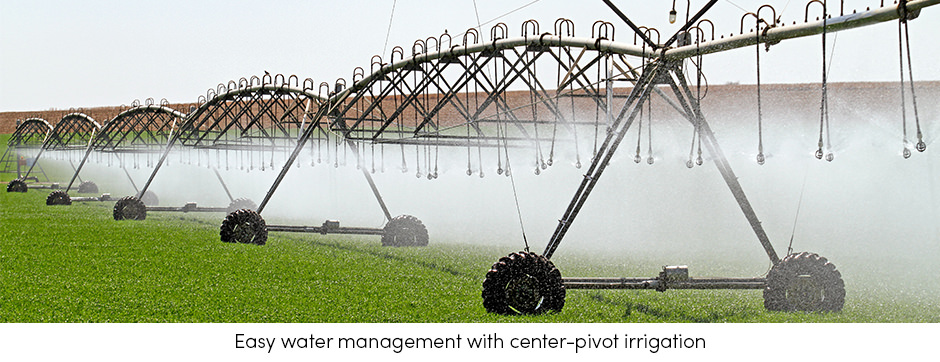Table of Contents
Irrigation in Agriculture
Proper irrigation with water is essential and the most important necessity for plant growth and the formation of quality and abundant fruits. The amount of water required by the plant depends on the growth phases during the season. The highest need for water is during the initial crop development, flowering, and fruit setting phases.
Since there are very few regions where precipitation is sufficient enough to satisfy crop needs, additional water must be provided artificially, by establishing an irrigation system. The lack of water during the growing season will lead to reduced yield and even possible failure of the entire crop production.
Agriculture is the largest consumer of the Earth’s available fresh water. Nearly 70% of water withdrawals from watercourses and groundwater are used in farming for crop irrigation.
What Is Irrigation in Agriculture
When it comes to agriculture, irrigation usually comes down to applying controlled amounts of water to assist in the production of crops, as well as to grow landscape plants and lawns. There are several different methods of watering that can be applied depending on the type of terrain, crop, water source availability, reservoirs, available infrastructure, and so on. Due to climate change and the need for increased food production, the amount of irrigation water has drastically increased and will continue to increase.
Irrigated farming represents 20 percent of the total cultivated land, but contributes to 40 percent of the total food produced worldwide.
Worldwide, over 324 million hectares are equipped for irrigation, of which about 85 percent, or 275 million ha, are actually irrigated.
5 Ways to Artificially Water Plants With Irrigation Systems
Irrigation systems are widely used in every crop production in order to apply the amount of water needed for the crop. The practice is also known as irrigation management. Despite its broad application, irrigation should occur in a uniform and timely manner in order to minimize losses and damage to soil, water, air, plant, and animal resources.
Irrigation is the artificial application of water to the soil at rates, quantities, and times needed to meet farm irrigation requirements. Water can be artificially supplied to plants using five irrigation systems:
- Flood or furrow irrigation; entire soil surface is covered with water; it moves over the field by gravity flow
- Sprinkler irrigation; crops are irrigated with high-pressure sprinklers set in the field; it can be solid or hand-moved
- Drip irrigation; water is placed directly into the crop root zone from the low flow emitters, this usually also involves drip irrigation systems
- Center Pivot irrigation; single central irrigation pipeline rotates around the pivot point. As it rotates, water sprinklers along the central pipe and irrigates crops
Limitations to Watering in Agriculture
Prior to setting up an irrigation system, a farmer must consider the following limiting factors in order to adequately set up:
- Soil properties; soil type, drainage, water holding capacity
- Water quality; availability, quality, quantity, crop water requirements
- Crop properties; yield potential, frost resistance, row space, harvest practices, rooting depth
- Climate requirements; humidity, temperature, precipitation
- Farmer capabilities; farm labor, financial health, management skills, farm practices
- Irrigation system properties; operating cost, and the ability to deliver and apply the amount of water needed to meet the crop’s water requirement.
The above-mentioned factors are important and should be considered prior to designing and managing an irrigation system. Moreover, all factors need to be managed well, in order to supply crops with water when they need it most.
Besides its primary function, to supply water to crops, irrigation systems help in crop and soil cooling, frost protection, delaying fruit and bud development, controlling wind erosion, germinating seeds, and fertilizer and pesticide application.
Since the dawn of agriculture, farmers have been irrigating their crops to ensure water is provided at the right time and at a rate at which the soil can absorb it without a runoff. Initially, irrigation was done manually, by using watering pots and early primitive irrigation systems.
With increasing awareness of water importance, irrigation systems have become more sophisticated, efficient, and more widely used among farmers. Modern irrigation not only saves time, but also saves water, improves crop growth, reduces weeds, and saves money.
Finally, every farmer knows that irrigation facilitates the management of crop production by providing crops with the most valuable resource, water.
How AGRIVI’s Water Management Benefits Farmers?
Sustainable water management for farmers means managing water they have access to for its best and highest use but also considering their ecosystem and future water needs. Improving water productivity in agriculture is essential and includes a thorough monitoring of water usage efficiency.
AGRIVI Farm Management Software offers comprehensive solutions for sustainable and efficient water management. This data-driven solution helps farmers monitor and evaluate the effectiveness of their irrigation system, ensuring optimal water utilization. By incorporating advanced data tracking and analysis, AGRIVI empowers growers to make informed decisions that have a positive impact on both their crops and the environment.
With AGRIVI, growers can meticulously record, track, and analyze every irrigation activity. For instance, a farmer can document the exact amount of water used, the timing of irrigation, the water source, and associated labor costs. This data serves as the foundation for calculating the irrigation Return on Investment (ROI) for specific crops, factoring in harvest returns and resource inputs.
AGRIVI also extends its water management capabilities by enabling farmers to manage and automate water distribution across their fields using our Internet of Things (IoT) hardware together with the new Fertigation Management System. In scenarios where water resources are limited, this technology becomes invaluable. By ensuring that water is delivered precisely where and when it’s needed, farmers optimize their resource allocation, conserve water, and save valuable time and labor.
Ready to see how AGRIVI can help you manage your irrigation decisions for a more sustainable, efficient and affordable system? Contact our experts for a free consultation, and find the right solution for your needs.










